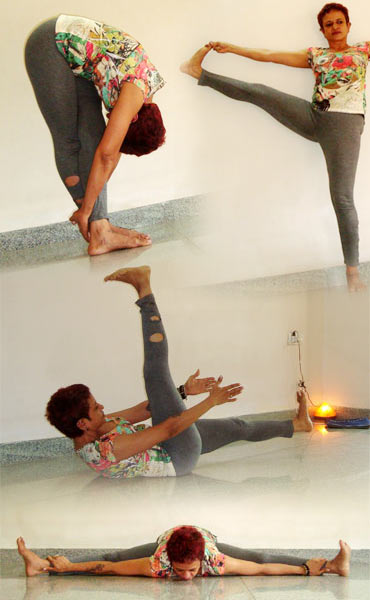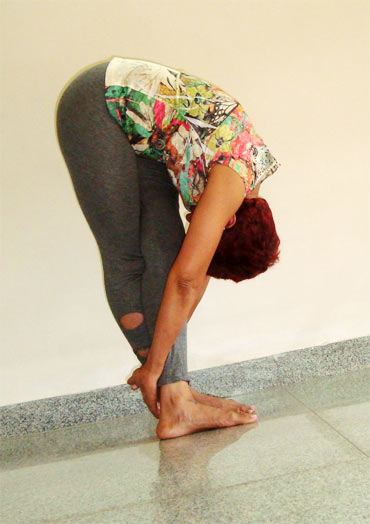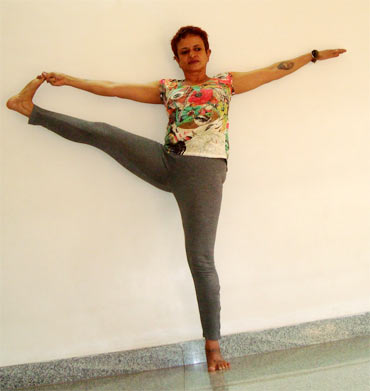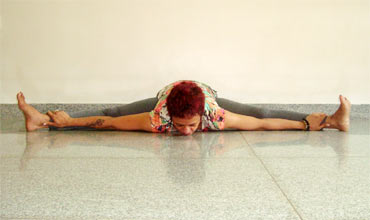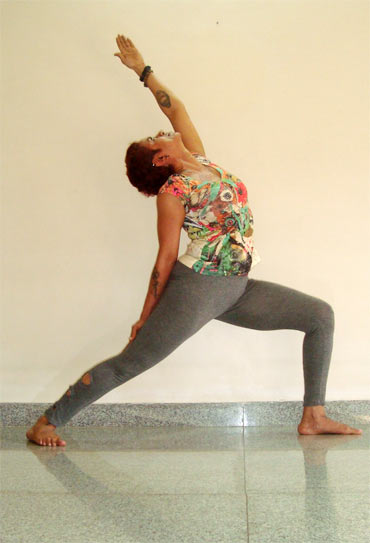 | « Back to article | Print this article |
Yoga for runners: Improve your performance
Shameem Akthar, yogacharya trained with the Sivananda Yoga Vedanta Center, shows five advanced poses to help runners keep to the track.
Runners enjoy running. This explains why they are willing to sacrifice the attendant health issues that come with this activity. This may surprise many who believe that running per se is very healthy and can have no negative health fall-outs. Though running per se is healthy, it also ushers a lot of musculo-skeletal problems.
Runners develop what is called the fast-twitch muscle fibers. This is great for power and sudden spurts of energy. However it is not as healing as the more supple slow-twitch muscle fibers that endurance activities create in the body. Ideally runners must focus on creating both types of muscle fibres to create a healing mode inside the body.
The slow twitch muscle fibres are created by activities like yoga and Tai Chi.
Since the feet pump into hard ground there is tremendous pressure at the joints, including delicate supportive ones like the knees and ankles. Most runners, if they do not take care, are heading towards worn-out knees that can create excruciating pain. Knee pain can be the most difficult to control once it becomes a full-blown one.
Since the rest of the muscles are also stiff instead of supple runners tend to develop overall muscle soreness. This can be sorted out by stretching before and after each practice. Other issues include neck pain (since this part of the body also takes tremendous jolts when running). Intriguingly, runners as well those who do jumping or other high-pressure activity like skipping can develop loose pelvic tone.
The pelvic muscles hold up the rest of the organs in the torso. In later life, this could cause loose tone at the abdomen, especially the insides as well as serious issues like incontinence and sexual problems. Using the yogic locks called bandhas, especially the ashwini mudra (anal lock) and moolabandha (master lock) would help maintain pelvic tone.
Making meditation and pranayama (yogic breathing practices) part of the daily yoga routine will boost lung capacity, help remove blood lactate levels in the blood (which builds up as a result of any activity) and remove stress hormone build up in the blood. Any intense activity is powered and accompanied by stress hormones because that is the only physiological interpretation the body has for a need to run.
For more of Shameem's yoga writings visit http://jaisivananda.blogspot.com. Shameem's second book Yoga in the workplace, with photographs by ace photographer Fawzan Husain, is now available at online shops and bookshops across the country. It is also available as e-book, with Kindle, Amazon.
Disclaimer: This column just shares the columnist's passion for yoga which is ideally learned under the guidance of an expert.
Click NEXT for more
Yoga for runners: Improve your performance
Uttanpadasana (Leg raise, Advanced version)
Lie on your back. Inhale, raising the right leg up. Exhale, to lift chest up, simultaneously lifting hands alongside right leg and lift the left leg off the ground. Hold initially for a ten to 15 seconds. You may increase the duration in the final pose over weeks, to a minute or more. Continue normal breathing while in the final pose.
To finish the pose, inhale and exhaling drop the legs and chest back to the ground. Press the chin between collar bones to release any contraction at the neck. Push the lower back curve into the ground to relax the back.
Repeat for the other leg.
Point to note: Attempt this pose only after doing the basic leg raises (given earlier in this section). This needs stamina and neck strength.
Avoid: If having lower back or neck problems.
Benefits: Tones the hands and legs superbly. Improves core muscles. Tones the spine. Boosts stamina overall.
Click NEXT for more
Yoga for runners: Improve your performance
Padahastasana ( Standing forward bend, Advanced)
Stand straight. Pass right leg over the left and place the right foot along the left. The legs are now crossed. Inhale, raising hands overhead. Exhaling bend forward. You may either place around the legs lightly, or place palms or fingers (depending on which reaches the ground) or place palms flat against each other behind the leg (as shown, this is an advanced version). Hold for a few seconds initially, increasing duration over weeks after regular practice. Normal breathing throughout.
Raise hands with an inhalation,to finish the pose. Repeat for the other side.
Avoid: If having lower back problems or vertigo.
Points to note: This also involves ability to balance, so while bending forward care must be taken to ensure you do not topple over.
Benefits: Tones the legs. Destresses by releasing all contracted muscles, and boosting blood circulation to the brain. Boosts sense of propriocepton (sense of body in space) which also means improved co-ordination, balance and postural corrections.
Click NEXT for more
Yoga for runners: Improve your performance
Utthita hasta padanugushtasana (Raised hand to toe pose)
Stand up straight. Fold right leg at knee. Hold big toe with right hand (ideally the index finger). Stretch the leg out to the side. Breathe normally throughout. The supporting left leg should be firmed up. In case you are unable to reach for the toes, you may hold the ankle or calf. This might require you to take a wall support with the left hand.
Hold for as long as possible, with comfort. Release the right leg by bending it at the knee, and dropping it to the ground. Repeat for the other leg.
Avoid: If having severe knee injury or lower back issues.
Benefits: Tones hips, legs and hands. Boosts focus.
Click NEXT for more
Yoga for runners: Improve your performance
Kurmasana (Tortoise)
Sit with the legs as wide as possible and without discomfort. Inhale, to raise hands as high as possible. Exhale, drop palms in front of the body. Hold this pose for a while. Then, gently move the palms a few centimetres ahead. Stop when you feel the intense stretch along the saddle region. This would be the limit you should not exceed in the pose. After regular practice you will find that you can increase the distance that the palms will cover. The final pose, as shown here, is an advanced version and may be attempted only after there is no pain in the first stage. Then you can naturally lower the head or torso (as shown) towards the floor. Continue normal breathing throughout.
Points to note: In this pose care must be taken to see that you are not attempting over your pain threshold. That should be a good barometer as to where you should stop.
Benefits: It is a complete body workout, toning the legs and the hands. It gives a powerful stretch to the entire spine. Strengthens the hips. Boosts digestion, immunity, respiration. Destresses.
Click NEXT for more
Yoga for runners: Improve your performance
Virabhadrasana (Warrior, advanced version)
Stand straight. Move the right leg as shown, foot lightly turned in. The left leg is bent at the knee. Inhale, raising the left hand overhead, so the inner arm touches the left ear. Exhale, passing the right hand long the back of the right thigh as shown. The right leg is curved but not bent along the knee. Lift your head towards uplifted hand. Hold for a few seconds initially, slowly raising stamina in the final pose with regular practice. Breathe normally throughout.
Avoid: If having vertigo or severe knee pain.
Point to note: Looking up involves ability to balance, so take the last stage slowly and with care.
Benefits: Strengthens and makes leg muscles supple. Improves balance and limb co-ordination. Boosts stamina, respiration and immunity.
